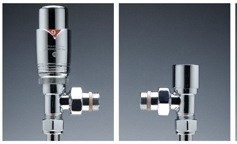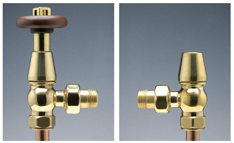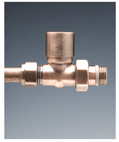
Radiator valves work by controlling the amount of hot water that flow through the pipes of a hot water central heating system to each radiator in the system.
Manual Radiator
Valves operate using the same principals as a tap. You simply manually turn the top of the valve to allow more or less water to enter your radiator depending on if you want the room warmer or cooler.

Thermostatic Radiator Valves
Self regulate to control the amount of water that enters a radiator. They will have a temperature dial which is easily pre set by the home owner to maintain the ideal room temperature. Thermostatic radiator valves contribute to the efficiency of the heating system helping you to save money on your heating bills.
Angled or Straight Body:
A radiator valve with a straight body joins the radiator to the central heating pipework in a straight, horizontal line across a wall or skirting.
An angled radiator valves, The radiator valve body has a 90° bend in it so will allow you to join the central heating pipework into the side of the radiator at an angle from the floor.
BI Directional Radiator Valves:
Convenient but not always the best solution unless you know exactly what you are doing. The temperature control of the radiator will be far more efficiently controlled the quicker the water entering the radiator is opened or closed.
The internal design of most thermostatic radiator valves are made to have the flow coming through the underside of the valve under the modulating plunger seat (which restricts or opens up the flow) and then up and over the internal body of the valve into the radiator.
If a thermostatic valve is installed on the outlet of a radiator the water flows down into the valve and over the top of the modulating plunger it can sometimes become noisy and inefficient. Systems are often operated at less than 1.5 bar to overcome this problem.
How To Replace a Radiator Valve
Once the central heating system is fully drained down you can start to replace your radiator valves. Do not try and fit the valve onto the existing radiator tail already in the radiator unless it is the same model of valve as they rarely match and can leak.
To replace the existing valve tail in the radiator you will need to unscrew it with a hex key inserted into the tail end and replace it with the new radiator tail by screwing the tail into the radiator having wrapped the thread with PTFE tape.
Once the new tail is installed place the compression nut for the new valve over the copper pipe followed by the new olive. Place the new valve onto the pipe and manoeuvre it so the pipe enters the valve and also aligns with the tail in the radiator as well.
Slowly tighten the nut on the radiator connection side and remember to hold the valve body with a wrench to prevent it twisting as you gradually tighten the joint.
Once the valve is fitted to the radiator tail we need to fit the valve to the copper pipe by pushing the pipe into the valve and screwing the compression nut up tight into the valve.
The olive will now be in the nut and will be compressed around the copper pipe to form a seal. Be careful not to over tighten the nut as you can crush or split it and cause a leak.






